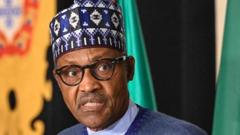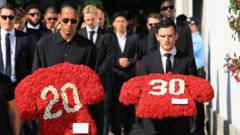Crowds filled St. Peter’s Square for Pope Francis' funeral where they witnessed a simplified mass that honored his vision of humility and inclusivity.
Pope Francis' Funeral: A Final Farewell as World Leaders Gather in Vatican City

Pope Francis' Funeral: A Final Farewell as World Leaders Gather in Vatican City
The late pontiff’s funeral saw a poignant blend of simplicity and ceremony, attended by thousands who mourn the first Jesuit pope’s legacy.
April 26, 2025, 4:48 a.m. ET, Vatican City — Thousands have gathered in the sunlit expanse of St. Peter’s Square to pay their respects to Pope Francis, whose funeral is an embodiment of his principles of humility and inclusivity. Mourners include a mix of world leaders, ordinary citizens, and religious figures, reflecting Francis' deep commitment to reach out to a broader audience during his papacy.
The funeral service takes place under a high degree of security amidst ongoing geopolitical tensions. The proceedings are marked by notable attendees such as President Trump and Ukrainian President Volodymyr Zelensky, who met briefly before the service, indicating an effort to foster stronger ties amid strained relations.
Pope Francis, who passed away at 88 on Monday, had previously opted for a less elaborate funeral than his predecessors, emphasizing a modest approach throughout his life and ministry. The 12-year pontiff had requested a wooden coffin that rests low to the ground, aligning with his vision of the papacy as one of service rather than hierarchy. The overall mass blends Catholic pageantry with simplicity, featuring prayers in multiple languages and a performance by the Sistine Chapel Choir largely in Gregorian chant, the traditional musical form of the church.
Notably, the choices for the funeral Mass readings reflect Francis' inclusive values. The first reading emphasizes the universality of the Gospel, resonating with his commitment to reach out to those traditionally marginalized by the church. The selections echo those dignified at the funeral of Pope John Paul II, providing a symbolic continuity in the church’s rich history.
The ceremonial aspect extends beyond the spiritual, as guests are organized in a thoughtful alphabetical arrangement to ease potential geopolitical tensions, demonstrating the Vatican's diplomatic awareness. As leaders and dignitaries navigate the ceremony, the atmosphere is intensified by rich traditions and the palpable grief of the faithful.
As the day unfolds, discussions will inevitably shift towards the election of his successor by the College of Cardinals, a pivotal moment for the future of the Catholic Church as it seeks to balance tradition with the evolving needs of its global congregation. Amidst the profound sadness, Pope Francis leaves a legacy of love, hope, and unity—one that many attendees hope will guide the direction of the church moving forward.
The funeral service takes place under a high degree of security amidst ongoing geopolitical tensions. The proceedings are marked by notable attendees such as President Trump and Ukrainian President Volodymyr Zelensky, who met briefly before the service, indicating an effort to foster stronger ties amid strained relations.
Pope Francis, who passed away at 88 on Monday, had previously opted for a less elaborate funeral than his predecessors, emphasizing a modest approach throughout his life and ministry. The 12-year pontiff had requested a wooden coffin that rests low to the ground, aligning with his vision of the papacy as one of service rather than hierarchy. The overall mass blends Catholic pageantry with simplicity, featuring prayers in multiple languages and a performance by the Sistine Chapel Choir largely in Gregorian chant, the traditional musical form of the church.
Notably, the choices for the funeral Mass readings reflect Francis' inclusive values. The first reading emphasizes the universality of the Gospel, resonating with his commitment to reach out to those traditionally marginalized by the church. The selections echo those dignified at the funeral of Pope John Paul II, providing a symbolic continuity in the church’s rich history.
The ceremonial aspect extends beyond the spiritual, as guests are organized in a thoughtful alphabetical arrangement to ease potential geopolitical tensions, demonstrating the Vatican's diplomatic awareness. As leaders and dignitaries navigate the ceremony, the atmosphere is intensified by rich traditions and the palpable grief of the faithful.
As the day unfolds, discussions will inevitably shift towards the election of his successor by the College of Cardinals, a pivotal moment for the future of the Catholic Church as it seeks to balance tradition with the evolving needs of its global congregation. Amidst the profound sadness, Pope Francis leaves a legacy of love, hope, and unity—one that many attendees hope will guide the direction of the church moving forward.























